News
Article
HER2 Amplification Shows Prognostic Capabilities in mCRC
Author(s):
Although HER2 amplification showed prognostic capabilities in patients with RAS wild-type metastatic colorectal cancer (mCRC), it was not predictive of survival benefit as a first-line treatment option in combination with panitumumab vs standard-of-care bevacizumab.
This article was originally published by OncLive®.
HER2 amplification appears to be prognostic in patients with RAS wild-type metastatic colorectal cancer (CRC) but may not be predictive of survival benefit as a first-line treatment option in combination with panitumumab (Vectibix) vs standard-of-care bevacizumab (Avastin), according to findings from a prospective study that evaluated data from the phase 3 PARADIGM trial (NCT02394795) were presented at the 2023 ASCO Breakthrough Conference.
Overall, patients who did not have HER2 amplification (n = 701) experienced a median overall survival (OS) of 34.1 months (95% CI, 31.3-36.3) compared with 24.6 months (95% CI, 17.5- 35.4), among those with HER2 amplification (n = 32; HR, 1.50; 95% CI, 1.03-2.19). The median progression-free survival (PFS) was 11.6 months (95% CI, 11.2-13.0) vs 12.2 months (95% CI, 9.2-15.0), respectively (HR, 1.11; 95% CI, 0.75-1.65).
Specifically, patients who received panitumumab plus mFOLFOX6 (5-fluorouracil, leucovorin, and oxaliplatin; n = 349) without HER2 amplifications (n = 349) experienced a median OS of 36.3 months (95% CI, 32.9-40.4) vs 23.0 months (95% CI, 16.5-30.6) for those with HER2 amplifications (n = 19; HR, 1.57; 95% CI, 0.96-2.57). The median PFS was 12.3 months (95% CI, 10.8-13.2) vs 12.2 months (95% CI, 9.2-15.0), respectively (HR, 1.15; 95% CI, 0.67-1.98).
Patients treated with bevacizumab plus mFOLFOX6 who were negative for HER2 amplifications (n = 352) experienced a median OS of 31.6 months (95% CI, 29.6-34.5) vs 26.7 months (95% CI, 15.0-37.1) for those positive for HER2 amplifications (n = 13; HR, 1.41; 95% CI, 0.79-2.52). The median PFS was 11.5 months (95% CI, 11.2-13.3) vs 9.8 months (95% CI, 7.6-25.3), respectively (HR, 1.06; 95% CI, 0.59-1.89).
Overall Population: Panitumumab vs Bevacizumab
In the overall population, patients treated with panitumumab plus mFOLFOX6 (n = 368) experienced a median OS of 35.6 months (95% CI, 31.1-38.9) compared with 31.6 months (95% CI, 29.3-34.5) for those given bevacizumab plus mFOLFOX6 (n = 365; HR, 0.87; 95% CI, 0.73-1.02; P = .703). The median PFS was 12.2 months (95% CI, 10.8-13.2) vs 11.5 months (95% CI, 22.2-13.3), respectively (HR, 1.07; 95% CI, 0.91-1.26; P = .832).
Patients without HER2 amplifications experienced a median OS of 36.3 months (95% CI, 32.9-40.4) in the panitumumab group (n = 349) vs 31.6 months (95% CI, 29.6-34.5) in the bevacizumab group (n = 352; HR, 0.86, 95% CI, 0.72-1.01). The median PFS was 12.3 months (95% CI, 10.8-13.2) vs 11.5 months (95% CI, 11.2-13.3), respectively (HR, 1.06; 95% CI, 0.90-1.26).
Patients with HER2 amplifications experienced a median OS of 23.0 months (95% CI, 16.5-30.6) in the panitumumab group (n = 19) vs 26.7 months (95% CI, 15.0-37.1) in the bevacizumab group (n = 13; HR, 0.96, 95% CI, 0.45-2.04). The median PFS was 12.2 months (95% CI, 9.2-15.0) vs 9.8 months (95% CI, 7.6-25.3), respectively (HR, 1.49; 95% CI, 0.63-3.49).
Left-Sided CRC Subgroup Analysis: Panitumumab vs Bevacizumab
Among patients with left-sided CRC (n = 554), those treated with panitumumab plus mFOLFOX6 (n = 287) achieved a median OS of 37.7 months (95% CI, 34.1-42.5) vs 34.1 months (95% CI, 30.8-38.3) for those given bevacizumab plus mFOLFOX6 (n = 267; HR, 0.83; 95% CI, 0.69-1.01; P = .748). The median PFS was 13.2 months (95% CI, 11.8-14.3) vs 12.0 months (95% CI, 11.2-13.5), respectively (HR, 1.00; 95% CI, 0.82-1.21; P = .969).
Patients without HER2-amplifications experienced a median OS of 38.1 months (95% CI, 35.1-43.3) in the panitumumab group (n = 271) vs 34.1 months (95% CI, 30.9-40.3) in the bevacizumab group (n = 256; HR, 0.82, 95% CI, 0.67-1.00). The median PFS was 13.1 months (95% CI, 11.3-14.2) vs 12.1 months (95% CI, 11.3-13.5), respectively (HR, 1.00; 95% CI, 0.82-1.22).
Patients positive for HER2 amplifications experienced a median OS of 25.1 months (95% CI, 16.5-40.7) in the panitumumab group (n = 16) vs 26.7 months (95% CI, 15.0-49.4) in the bevacizumab group (n = 11; HR, 0.89, 95% CI, 0.39-2.04). The median PFS was 14.3 months (95% CI, 9.2-16.4) vs 9.8 months (95% CI, 7.6-27.7), respectively (HR, 1.20; 95% CI, 0.48-3.02).
Right-Sided CRC Subgroup Analysis: Panitumumab vs Bevacizumab
In patients with right-sided disease (n = 169), those treated with panitumumab plus mFOLFOX6 (n = 78) achieved a median OS of 20.8 months (95% CI, 15.1-32.0) vs 25.5 months (95% CI, 19.1-31.3) for those given bevacizumab plus mFOLFOX6 (n = 91; HR, 1.12; 95% CI, 0.80-1.56). The median PFS was 7.7 months (95% CI, 6.8-9.9) vs 10.6 months (95% CI, 7.4-14.3), respectively (HR, 1.48; 95% CI, 1.06-2.07).
Patients without HER2 amplifications experienced a median OS of 22.0 months (95% CI, 15.1-34.8) in the panitumumab group (n = 75) vs 25.5 months (95% CI, 19.1-31.3) in the bevacizumab group (n = 89; HR, 1.11, 95% CI, 0.79-1.56). The median PFS was 8.0 months (95% CI, 6.6-10.6) vs 10.6 months (95% CI, 7.4-14.3), respectively (HR, 1.46; 95% CI, 1.04-2.05).
Data for those with HER2 amplifications in the panitumumab (n = 3) and bevacizumab groups (n = 2) was not calculated because of the small sample size.
Baseline Patient Characteristics
Patients included in the prospective study had unresectable disease, were aged 20 to 79 years, had an ECOG performance status of 0 or 1, and had at least 1 evaluable lesion.
Those with HER2-negative disease in the panitumumab arm (n = 349) and bevacizumab arms (n = 352) were female (37.2% vs 33.2%), aged 65-79 years (59.6% vs 58.5%), had an ECOG score of 0 (83.4% vs 79.0%), left-sided tumors (77.7% vs 72.7%), 2 or more metastatic organs (49.6% vs 50.3%), had the liver as the only site of metastasis (26.4% vs 28.1%), and previously underwent primary tumor resection (60.7% vs 67.0%).
Those with HER2-positive disease in the panitumumab arm (n = 19) and bevacizumab arms (n = 13) were female (21.1% vs 23.1%), aged 65-79 years (57.9% vs 53.8%), had an ECOG score of 0 (68.4% vs 76.9%), left-sided tumors (84.2% vs 84.6%), 2 or more metastatic organs (73.7% vs 76.9%), had the liver as the only site of metastasis (21.1% vs 23.1%), and previously underwent primary tumor resection (52.6% vs 61.5%).
Reference
Oki E, Muro K, Watanabe J, et al. First-line (1L) panitumumab (PAN) vs bevacizumab (BEV) in patients (pts) with HER2 amplification (HER2 amp+) RAS wild type (WT) metastatic colorectal cancer (mCRC) according to tumor sidedness. JCO Global Oncology. 2023;9(suppl 1):53. doi:10.1200/GO.2023.9.Supplement_1.53
Newsletter
Stay ahead of policy, cost, and value—subscribe to AJMC for expert insights at the intersection of clinical care and health economics.




